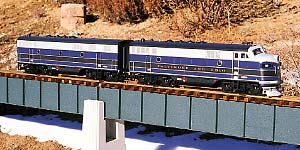1:29 scale, gauge-1 F3 A and B units
USA Trains
PO Box 100
Malden MA 02148
www.usatrains.com
Check with your local dealer for price and availability
Plastic models of F3 diesels; A and B units sold together; each unit has two motors and four powered axles; working smokestacks; directional marker and headlights; rubber diaphragms; metal handrails; constant-voltage lighting; lit and detailed cab interior; 12 pickup points per unit; on-off switches for motor, lights, rear light, smoke, and sound (sound unit not included). Dimensions: Height, 53/4″; width, 41/16″; length, 197/8″ (A unit), 193/8″ (B unit). In 1:29 scale, this works out to 13′-11″ x 9′-10″ x 48′-4″ (A), 46′-10″ (B). Current draw at full speed: 2 amps (both units). Current draw at full load (wheels slipping): 6.5 amps. Tractive effort (both units): 89 oz., or the equivalent of about 71 standard freight cars
Pros Excellent fidelity to prototype; high level of detail; excellent graphics; small parts in metal; good running characteristics
Cons Rubber diaphragms extend beyond prototype length and don’t compress; smoke generators can burn out if directions are not followed to the letter; inaccurate scale/gauge combination
USA’s F3s are available in a variety of different road names. Our review sample is decorated in Baltimore & Ohio’s blue/gray/black livery, with gold lettering. Colors appear accurate and the graphics are up to USA’s usual high standard. Metal details include grab irons, uncoupling levers, and fan blades (which rotate if you blow on them). The engines are supplied with hook-and-loop couplers, but USA knuckle couplers are also provided. The front coupler on the A-unit is a dummy, scale-size coupler. Under close examination, its shape appears wrong. It can be swapped out for the larger working knuckle, if you wish, but a portion of the pilot must be removed to do so. This involves snapping out a section of plastic around the coupler.
The locomotives are equipped with the so-called “chicken wire” grill above the portholes. These are finely made metal screens. A couple of them on our review samples buckled a little, though they were securely fastened. There are also metal screens in the roofs of the engines.
The soft rubber diaphragms are a nice feature. However, because of the over-long coupling distance between the two units, they stick out too far for my eye. If the couplings were tightened up, the diaphragms might possibly be trimmed to fit more closely. As molded, these diaphragms do not compress. Actual compression diaphragms would be better. A creative modeler might be able to make his own.
Scale-wise, the locomotives get high marks. Their overall dimensions are very close to those in drawings that I have. Each railroad modified its engines or ordered them with different details, so the locomotives you purchase may not exactly match those of your chosen line in every minor respect.
The engines operate well, though there is some motor noise, particularly at high speed. Top speed (22V) did not seem excessive and extreme slow-speed operation was excellent. Each truck has two traction tires and the two locomotives together should easily be able to handle your longest trains.
USA Trains’ F3s are well up to the standard we have come to expect in its locomotives. They look good, scale out well, have loads of detail and extra features, and are good performers. Who could ask for more?













